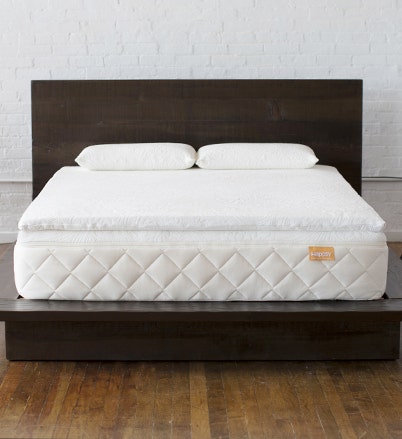
There’s nothing like comfy, restorative sleep … and tiny bits of glass. Wait, what?
We're going to go ahead and assume those are two phrases you don't associate with one another – for obvious reasons! So, why is fiberglass in some mattresses? Is it in certified organic mattresses?
Fiberglass is a reinforced plastic woven with extremely fine glass fibers. Among other uses, fiberglass can act as a cheap and easy-to-produce flame retardant, which is why there is fiberglass in some mattresses. Is there fiberglass in your mattress? And is fiberglass in mattresses safe? Read on to learn.


Fiberglass is actually all throughout your home
The truth is you probably have fiberglass all throughout your home already. Whaaat?
That’s right: fiberglass is most commonly used in home insulation. You know, that pink, fluffy, cotton-candy-like material in your walls and attic? That your parents warned you was NOT really cotton candy and was NOT to be touched? That’s fiberglass insulation!
Properly installed insulation in the home is not known to cause adverse health effects, so long as the insulation is not exposed in commonly occupied spaces. However, there are more natural and eco-friendly options available – like wool, denim and cork, just to name a few.
Are there any health risks with fiberglass?
Did you catch the caveat in our above statement? Fiberglass insulation isn’t known to harm human health … if it is installed properly. Open-air exposure to fiberglass can and does come along with health risks. These can include:
- Rashes and blisters when touched
- Eye irritation
- Lung irritation
- Worsened asthma
Moreover, once fiberglass is released into the home, it is impossible to remove without a professional. Tiny glass particles settle on surfaces, seep into fabrics and can even make their way into your HVAC system. Invisible to the naked eye, fiberglass particles can make you sick without you even realizing they’re there. Pretty scary stuff.
Is fiberglass in mattresses safe?
The short answer? No!
Fiberglass is used in mattresses as a cheap flame retardant. When used as a flame barrier, fiberglass causes mattresses to melt rather than to burn, slowing the spread of fire. You might be thinking, “Does a mattress even need a flame retardant?” The short answer? No again
However, this time it’s more complicated. Your mattress does need to pass government flammability regulations. Many mattress materials (chiefly memory foam) are highly flammable – so much so that the CPSC put The Standard for the Flammability of Mattress Sets in place in 2007.
Some mattress manufacturers have turned to fiberglass as an alternative to chemical flame retardants. It’s not going to increase your risk of cancer like flame retardants can (more in a second!) … but it’s just another cheap, easy way for mattress companies to pass flammability regulations without protecting your health.
If your mattress cover becomes damaged, or if you were to unwittingly unzip your mattress cover without reading the tag that says “DO NOT REMOVE” (which happens more often than you’d think), tiny fiberglass fibers can escape and wreak havoc on your home and your health. When it comes to flame barriers, fiberglass is NOT the safest way to go.


OK, but you don't want flame retardants either
It’s true – flame retardant chemicals are the cheapest and easiest way to pass the regulations, but they off-gas toxins associated with serious health issues. In fact, fiberglass is often marketed as a healthier alternative to the flame retardant chemicals linked to a host of adverse health effects, such as:
- Cancer
- Neurological issues
- Hormone disruption
- Decreased fertility
Repeated exposure to flame retardants can lead to bioaccumulation in the body and chronic health issues. Mothers have even been known to pass flame retardant chemicals to their babies through breastfeeding. On top of it all, flame retardants are often ineffective … so they aren’t even worth the risk!
Happsy can keep you safe from both!


At Happsy, we know there is a better way to meet mattress flammability standards and keep you safer while you sleep. And it doesn’t have to come at the cost of your health!
When you don’t use highly flammable materials in the first place, you don’t have to douse your mattresses in flame retardants or wrap them in fiberglass. Happsy mattresses are made with the finest materials Mother Nature has to offer – organic cotton, wool and latex.
Natural cotton and wool tend to smolder when exposed to fire, whereas petroleum-based foams quickly ignite, burn and burn hot. And, while latex is much more flammable, we’ve figured a design that protects you from that risk. Happsy certified organic mattresses meet and exceed federal flammability regulations – without having to use any of the bad stuff. We’ve got the certifications to back that up, too.
On top of that, Happsy organic mattresses are handcrafted with quality built to last, sustainably made to support our planet and oh-so-comfy. (Made from Mother Nature’s finest, how could they not be?) Ready to get healthier, Happsier sleep? Shop the mattress.


